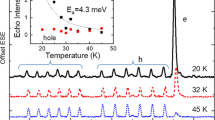Abstract
The influence of free carriers on optically detected magnetic resonance (ODMR) signals for defects in silicon is discussed. The presence of free carriers induces a strong background signal in the ODMR spectrum due to carrier heating effects in a microwave field. This background signal often obscures a possible detection of a defect-related magnetic resonance signal and is therefore highly undesirable. To avoid this problem, a delayed ODMR (D-ODMR) technique is employed. On the other hand, the presence of free carriers provides a medium for a possible ODMR detection of nonradiative defects. This is realized by a shunt pass of carrier recombination at such defects, which competes with the radiative carrier recombinations detected optically, and gives rise to negative ODMR signals for the defects responsible for the nonradiative recombination. Typical examples from recent studies of these different cases of defects in silicon are demonstrated.
Similar content being viewed by others
References
B.C. Cavenett: Adv. Phys. 30, 475 (1981)
W.M. Chen, B. Monemar, M. Godlewski: Defect and Diffusion Forum 62/63, 133 (1989)
G.D. Watkins: Proc. Int. Workshop on the Hyperfine Interaction of Defects in Semiconductors, Cargése, France, Aug. 27–31, 1990, to be published
J.M. Spaeth: Proc. Int. Workshop on the Hyperfine Interaction of Defects in Semiconductors, Cargése, France, Aug. 27–31, 1990, to be published
K.M. Lee, K.P. O'Donnell, J. Weber, B.C. Cavenett, G.D. Watkins: Phys. Rev. Lett. 48, 37 (1982)
K.P. O'Donnell, K.M. Lee, G.D. Watkins: Physica 116B, 258 (1983)
J. Weber, G.D. Watkins: Proc. 13th Int. Conf. on Defects in Semiconductors, Coronado, ed. by L.C. Kimerling, J.M. Parsey, Jr. (The Metallurgical Society of AIME, Warrendale, PA 1985) p. 661
R. Romestain, C. Weisbuch: Phys. Rev. Lett. 45, 2067 (1980)
P.G. Baranov, Yu.P. Veshchunov, R.A. Zhitnikov, N.G. Romanov, Yu.G. Shreter: JETP Lett. 26, 248 (1977)
B.C. Cavenett, E.J. Pakulis: Phys. Rev. B 32, 8449 (1985)
E.J. Pakulis, G.A. Northtrop: Appl. Phys. Lett. 50, 1672 (1987)
M. Godlewski, H. Weman, F.P. Wang, B. Monemar, W.M. Chen, Q.X. Zhao: In Defects in Electronic Materials, ed. by M. Stavola, S.J. Pearton, G. Davies, Mat. Res. Soc. Symp. Proc., Vol. 104 (1988) p. 117
H. Weman, M. Godlewski, B. Monemar: Phys. Rev. B 38, 12525 (1988)
W.M. Chen, Q.X. Zhao, M. Ahlström, B. Monemar: In The Physics of Semiconductors, ed. by W. Zawadzki (Institute of Physics, Polish Academy of Sciences, Warsaw 1988) p. 279
F.P. Wang, B. Monemar, M. Ahlström: Phys. Rev. B 40, 11195 (1989)
W.M. Chen, B. Monemar, P.O. Holtz, M. Sundaram, J.L. Merz, A.C. Gossard: Mat. Res. Soc. Symp. Proc. Vol. 160, 707 (1990)
M.C. DeLong, I. Viohl, W.D. Ohlsen, P.C. Taylor, J.M. Olson: Phys. Rev. B 43, 1510 (1991)
For simplicity we only consider here free electrons and one class of deep BEs. Similar conclusions may be reached when the discussion is extended to a more general situation where more particles and excitations are included. For the same reason a term describing the thermal dissociation of the BEs is not included in (4), since we believe it plays only a minor role in the kinetics of the electrons and the BEs at very low temperature (the carrier thermal energy is in most cases much smaller than the binding energy of the deep BEs). In (4) we also assume that BE formation can be approximately described by the term γ 2e
W.M. Chen, B. Monemar: J. Appl. Phys. 68, 2506 (1990)
M. Singh, E.C. Lightowlers, G. Davies, C. Jeynes, K.J. Reeson: Mater. Sci. Eng. B 4, 303 (1989)
D.J.S. Beckett, M.K. Nissen, M.L.W. Thewalt: Phys. Rev. B 40, 9618 (1989)
A. Henry, W.M. Chen, E. Janzén, B. Monemar: Proc. 20th Int. Conf. on the Physics of Semiconductors, Thessaloniki, Greece, Aug. 6–10, 1990, ed. by E.M. Anastassakis, J.D. Joannopoulos (World Scientific, Singapore 1990) p. 545
M. Kleverman, H.G. Grimmeiss, A. Litwin, E. Janzén: Phys. Rev. B 31, 3659 (1985); A. Hangleiter: Phys. Rev. B 35, 9149 (1987); A. Hangleiter: Phys. Rev. B 37, 2594 (1988)
A.G. Milnes: Deep Impurities in Semiconductors (Wiley, New York 1973)
W.M. Chen, O.O. Awadelkarim, H. Weman, B. Monemar: Phys. Rev. B 40, 10013 (1989)
W.M. Chen, O.O. Awadelkarim, J.H. Svensson, B. Monemar, F.P. Wang: Proc. 20th Int. Conf. on the Physics of Semiconductors, Thessaloniki, Greece, Aug. 6–10, 1990, ed. by E.M. Anastassakis, J.D. Joannopoulos (World Scientific, Singapore 1990) p. 601
F. Rong, G.D. Watkins: Phys. Rev. Lett. 58, 1486 (1987)
J.J. Davies: J. Phys. C 16, L867 (1983)
M. Godlewski, W.M. Chen, B. Monemar: Phys. Rev. B 37, 2570 (1988)
W.M. Chen, O.O. Awadelkarim, B. Monemar, J.L. Lindström, G.S. Oehrlein: Phys. Rev. Lett 64, 3042 (1990)
W.M. Chen, B. Monemar: Phys. Rev. B 40, 1365 (1989)
Author information
Authors and Affiliations
Additional information
Dedicated to H.-J. Queisser on the occasion of his 60th birthday
Rights and permissions
About this article
Cite this article
Chen, W.M., Monemar, B. Role of free carriers in the application of optically detected magnetic resonance for studies of defects in silicon. Appl. Phys. A 53, 130–135 (1991). https://doi.org/10.1007/BF00323872
Received:
Accepted:
Issue Date:
DOI: https://doi.org/10.1007/BF00323872




